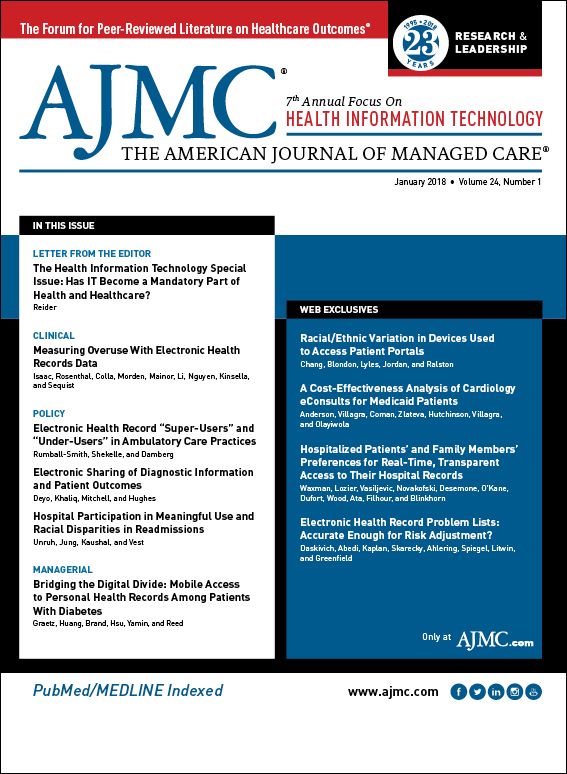- Center on Health Equity & Access
- Clinical
- Health Care Cost
- Health Care Delivery
- Insurance
- Policy
- Technology
- Value-Based Care
The Health Information Technology Special Issue: Has IT Become a Mandatory Part of Health and Healthcare?
The 7th annual Health Information Technology (IT) issue provides a window into how health IT tools are working well, how they may not be working as intended, and what we can do to continue making progress toward optimal use of technology to accomplish our shared goals: better health, better care experience, and lower per capita cost.
Am J Manag Care. 2018;24(1):17On March 11, 1928, the barge Northern No. 17, bound for Plymouth, Massachusetts, with a full load of coal from Norfolk, Virginia, sank in gale force winds off the New Jersey coast. Captain Samuel Fowler and 3 of his crew were rescued by the tug Montrose.1 The owners of the cargo sued the barge owners, and the barge owners sued the owners of the tug, asserting that the absence of a functional radio on the tug caused the tug captain to be unaware of the storm’s approach. Three other tugs in the area, all with radios, received the warning and found safe harbor. The courts found that the tug owner was liable for the loss, as many other tugs did have radio receivers, even though there was neither law nor regulation that required them to have these devices: “some have thought a device necessary, at least we may say that they were right, and the others too slack.”2
In 2018, are care delivery organizations slack if they do not use health information technology (IT)? Is it self-evident that these tools are necessary for optimal care delivery?
Nearly 80 years after barge No. 17 succumbed to the Atlantic Ocean, there was emerging evidence that such systems, properly implemented, could improve outcomes, reduce costs, and enhance safety. A 2005 RAND Corporation study summarizing many of the potential benefits of health IT implementation, based on decades of experience in innovative organizations that had implemented such systems in the 1980s and 1990s, explicitly called for government to “accelerate market forces, and subsidize change.”3
In 2009, Congress passed the Health Information Technology for Economic and Clinical Health Act, part of the American Reinvestment and Recovery Act, to promote the adoption and meaningful use of health IT. At the time, a minority of medical practices had implemented IT and an even smaller minority of hospitals had made such investments, but with the RAND study widely read and these early adopters reporting success, there was great enthusiasm for the improvements that we would see from these investments.
Like the radios of 1928, meaningful use of health IT was not required of care providers or hospitals, but the financial incentives were so compelling that many organizations considered the initiative a mandate. In October 2017, Anna Konopka, MD, a physician in New London, New Hampshire, lost her license to practice in part because she did not make use of the state prescription monitoring database. This episode suggests that some use of IT will be required of all care providers.4
Yet the success of early adopters, cited by the RAND study and others, was not an accurate predictor of widespread success. A sophisticated early adopter is very different from a real-world practice or hospital without sufficient people or processes to select, implement, and optimize health IT systems. As one community hospital leader once said to me, “Not all of us can be Massachusetts General Hospital!” Do we fully understand what is necessary for successful implementation in the 80% of hospitals and care delivery organizations that were not early adopters? Do we fully understand the unintended consequences? The safety concerns? The workflow and efficiency concerns?
Not yet. This impressive issue of The American Journal of Managed Care® offers a step in this direction and provides a window into how these tools are working well, how they may not be working as intended, and what we might be able to do in order to continue making progress toward optimal use of technology to accomplish what we all agree are our shared goals: better health (for all), a better care experience (for patients and providers), and, as a byproduct of the first 2 goals, lower per capita cost. Jacob Reider, MD, is CEO of Alliance for Better Health and the Guest Editor-in-Chief for the health IT issue of The American Journal of Managed Care®.REFERENCES
1. Rescue 9 when barges sink. The Evening Journal (Wilmington, Delaware). March 12, 1928:4.
2. T.J. Hooper v Northern Barge Corp, 60 F2d737 (NY 1932).
3. Hillestad R, Bigelow JH, Fonkych K, et al. Health information technology: can HIT lower costs and improve quality? RAND Corporation website. rand.org/pubs/research_briefs/RB9136.html. Published 2005. Accessed December 3, 2017.
4. Wotus M, Orjoux A. A doctor who won’t use a computer loses her license to practice medicine. CNN. November 28, 2017. cnn.com/2017/11/28/health/new-hampshire-doctor-license-injunction-request-denied-trnd/index.html. Accessed December 3, 2017.

Managed Care Reflections: A Q&A With Laurie C. Zephyrin, MD, MPH, MBA
November 12th 2025To mark the 30th anniversary of The American Journal of Managed Care, each issue in 2025 includes a special feature: reflections from a thought leader on what has changed—and what has not—over the past 3 decades and what’s next for managed care. The November issue features a conversation with Laurie C. Zephyrin, MD, MPH, MBA, senior vice president for achieving equitable outcomes at the Commonwealth Fund. This interview has been edited for length and clarity.
Read More

